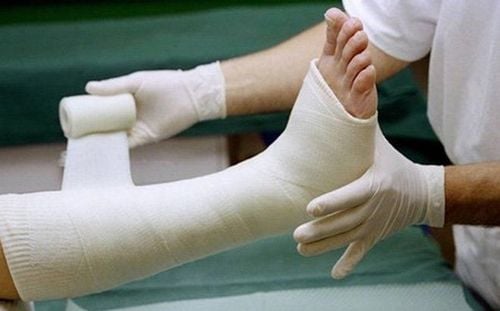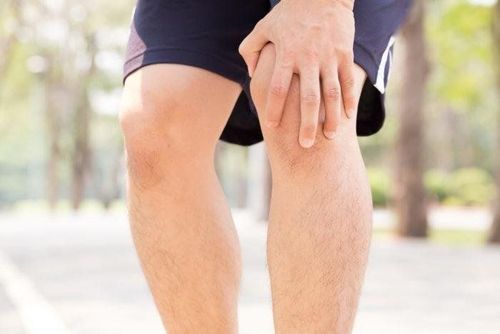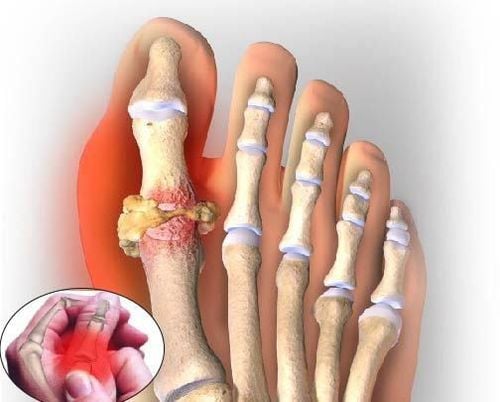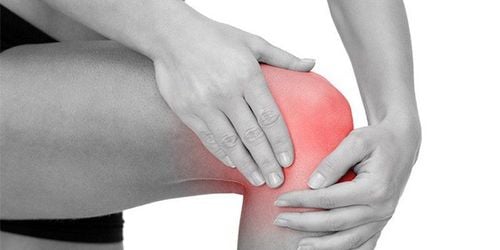This is an automatically translated article.
A child's fracture is not something any parent wants to happen to their child and in most cases there is usually no need to worry about these types of injuries as it is not life threatening.
Fractures can happen at any age, especially for babies at birth, because their skin and bones are still very weak. In many cases, mild bruising is a normal part of the birthing process, but fractures often indicate that something happened during delivery that could have been prevented. In this article, we will provide useful information to help caregivers promptly recognize and treat children with broken bones.
1. How to know if a child has a broken bone?
In fact, it can be difficult for parents to determine whether a child has a broken bone or not, because in some cases the bone may not be broken, but only sprained. Children's bones are usually very flexible, so they rarely break. If the child's wound is only slightly swollen and the child himself does not feel much pain, the parents do not need to be too worried, parents can use an ice pack to apply on the swelling (should be line with a cloth such as a face towel) and monitor for one to two days. If the wound has reduced swelling and returned to normal, parents can rest assured that the child can continue to participate in normal activities, but if the wound shows no signs of swelling, or even gets worse, the Parents should call the doctor or go to the nearest medical facility to check on the child. Of course, if parents feel really worried and can't guarantee the extent of the injury, they should take their child to the doctor right away during the first fall.
In addition, parents may notice some other signs of fracture such as:
There is a crackling sound like a broken bone. The injured area is bruised The child complains of severe pain, especially in one area. Pain increases with any sign of movement. Parents should also not be subjective when seeing that children can move their limbs or count the numbers on their hands, their hands are not broken. The child has a limp or the inability to stand or walk for a toddler. Some children will not be able to stand or walk because the damage to the bone is more severe than the outside. The child's legs and arms are bent or deviated from their original position.

Trẻ kêu đau dữ dội, đặc biệt ở một khu vực tổn thương
2. What should parents do if they notice a broken bone in their child?
If the child has an accident that causes the bone to pierce the skin (open fracture), the parents immediately call an ambulance or quickly take the child to the nearest medical facility for emergency treatment. This type of fracture will lead to an open wound, when there is a leak, the risk of infection is quite high, becoming a danger for young children. Parents or people around should not touch the wound even to wash the wound to minimize the risk of infection. When dressing open wounds always use medical gloves and gauze, sterile, antibacterial cloth.
If the parents suspect that the child has neck, back or skull injuries, the child is motionless on the ground, etc., they should wait for the ambulance to arrive to determine the position of the neck and back bones for the child. before putting the child in the ambulance. It will be very dangerous if the people around carry the child to the ambulance to go to the emergency because it may cause injury to the spine and neck bones of the child.
When a child has a broken bone, the best thing parents can do is protect and immobilize the injured area, ensuring that the child does not suffer more serious injuries. Besides, parents should also help the child calm down by comforting, encouraging and comforting the child so that the child is no longer afraid. If a child has a fracture that is not life-threatening, the doctor will probably ask the parent to take the child to the emergency room for an examination (possibly combined with an X-ray to diagnose the fracture) and advice. about steps to safely move children. Parents should also be careful not to give their child anything to eat or drink, as it can interfere with medical treatment, if the bones need to be reset or in cases where the child needs surgery. The doctors had to wait to anesthetize the child on an empty stomach. Parents and people around, if you do not have a professional qualification in medical treatment, never try to straighten the wound or arbitrarily change the position of a dislocated joint or broken bone, this is very dangerous. , which can make the wound worse and more difficult to treat.
Parents also need to watch out for symptoms of shock or internal bleeding, if you see injuries to the head, chest or abdomen, immediately call an ambulance or take the child to the nearest medical facility. In addition, the child should also be taken to the nearest medical facility when the child has any of the following fracture symptoms:
The child's pulse is weaker than usual, faster or irregular. The child's skin is rough or pale. The child breathes quickly, the breathing is shallow The child loses consciousness or is confused, does not remember what happened and does not know what is wrong with himself The child coughs up blood or vomits blood.
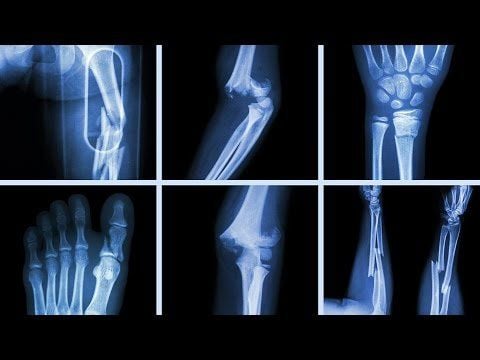
Chụp X-quang chẩn đoán gãy xương ở trẻ nhỏ
3. How to move children safely?
In cases of suspecting that a child has a serious injury to the head, neck or spine, parents and people around, without expertise, are not allowed to arbitrarily move the child from the original position. But if the child has a severe fracture it is important to immobilize the injured bone or joint first with items such as splints, braces, etc. This will minimize any injury and will be convenient. for easier movement of children. Each different injury area will have its own method of wound protection.
4. What should I do if I cannot get medical help right away?
In some cases where paramedics or ambulances arrive later than usual, parents can pre-apply some pain relievers for children to use such as acetaminophen and ibuprofen to control the pain. of children. In addition, the following ICES (Ice Compression Elevation Support) approaches can be followed:
Use an ice pack to reduce swelling and pain for the child, if there is no ice pack nearby, the parents should wrap it. a few ice cubes in a dish towel or plastic bag and hit them with a hammer, or on some solid object. Or simply take a bag of frozen vegetables from the freezer and wrap them in a towel. Keep the bag on the affected area for at least 20 minutes, use 4 times a day.
After the parents have applied ice to the wound, wrap an elastic bandage or cloth around the injured area, it should be wrapped just right, not too tight or too loose. In addition, the child needs to be kept still, place a pillow under the affected limb so that it is about 6 inches above the child's heart to support immobilization of the limb and reduce pain. A splint may be placed to immobilize the affected limb because the child can move the wound during movement. If parents suspect a broken arm, rib, or collarbone, a piece of cloth should be used to hold the arm in a flexed position next to the child's body.
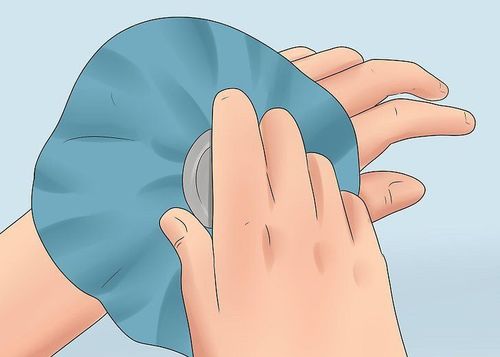
Sử dụng túi chườm lạnh để kìm hãm cơn đau của trẻ
5. How to fix the fracture position?
If the child has a severe fracture, it is best for parents to call an ambulance as quickly as possible. However, there will be many cases where an ambulance is not a good option, use anything to form a simple splint. For example, parents can use a ruler, a roll of tissue, a small hard pillow, a book, or any other hard, straight object. Make sure the splint is slightly longer than the broken joint, then wrap the support with a soft cloth band to protect the skin, using a handkerchief, belt, cloth band, shoelace, towel, or right away. including ties to immobilize, not move the injured limb - at the upper and lower joints. For example, if a child's leg is broken, parents should attach a brace to the child's knee and ankle or, in cases of collarbone fracture, raise the arm of the injured side and tie the sling around the shoulder on the other side. opposite. If parents can move the child without causing much pain, without affecting the wound, then skip the emergency stage and take the child to the nearest doctor's room.
Fracture is a dangerous condition for children especially with large bones in the body and can be very painful for the child. Fracture recognition is relatively difficult, especially in closed fractures. For children with open fractures, parents can easily recognize and call an ambulance to take the child to a medical facility immediately, but with a closed fracture, this condition needs to be checked by a doctor. examination, diagnosis, and even imaging tests to confirm for sure whether a child has a broken bone or not. Parents also absolutely should not touch or touch the suspected broken bone because this can make the injury more serious.
When a child shows abnormal signs of health, parents can take the child to Vinmec Health system for timely examination and treatment.
As a key area of Vinmec Health System, Pediatrics Department - Vinmec International General Hospital always brings satisfaction to customers and is highly appreciated by industry experts thanks to the following advantages:
gathers a team of leading doctors and doctors in Pediatrics: including leading experts, with high professional qualifications (professors, associate professors, doctorates, masters), experienced, having worked in different hospitals. big hospitals like Bach Mai, 108.. The doctors are all well-trained, professional, have a heart - reach, understand young psychology. In addition to domestic pediatric specialists, the Department of Pediatrics also has the participation of foreign experts (Japan, Singapore, Australia, USA) who are always pioneers in applying the latest and most effective treatment regimens. . Comprehensive services: In the field of Pediatrics, Vinmec provides a series of continuous medical examination and treatment services from Newborn to Pediatric and Vaccine,... according to international standards to help parents take care of their baby's health from birth to childhood. from birth to adulthood Specialized techniques: Vinmec has successfully deployed many specialized techniques to make the treatment of difficult diseases in Pediatrics more effective: neurosurgery - skull surgery, stem cell transplantation. blood in cancer treatment. Professional care: In addition to understanding children's psychology, Vinmec also pays special attention to the children's play space, helping them to have fun and get used to the hospital's environment, cooperate in treatment, improve the efficiency of medical treatment.
Please dial HOTLINE for more information or register for an appointment HERE. Download MyVinmec app to make appointments faster and to manage your bookings easily.
Reference source: babycenter.com; whattoexpect.comMORE:
Fracture: Causes, symptoms, diagnosis and treatment Fracture, signs of fracture and treatment First aid for fracture





